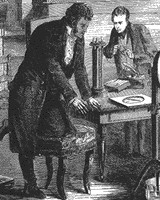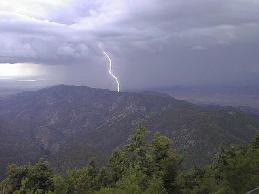|
Earlier today I was asked to tell you about the magnetosphere, about the complicated interaction involving the Earth's magnetism, the solar wind and magnetic phenomena on the Sun's surface, like sunspots. It is hard to teach your students about those subjects, unless both you and they have a clear understanding of the nature of magnetism. (One can also argue, that one reason for teaching about the magnetosphere is, to make the study of magnetism more interesting!) I regret to say that even in this day and age, most of the public regards magnetism as a mystery. That has led to magnetic bracelets and similar "health products," to magnets taped to fuel lines for better gas mileage, and to widespread worries about possible reversal of the Earth's field, encouraged by Hollywood movies. In the minds of most Americans magnetism is forever associated with specially treated iron, with patterns of iron filings and with the way the compass needle lines up with the north-south direction. Few schools teach much more, because, (1) physics is an elective, and (2) magnetism is covered near the end of the textbook, the school year is short, and teachers are happy if they just make it to Ohm's law. Some people may also know that a current-carrying wire coil wrapped around an iron bar turns it into a magnet, and about use of electromagnets in electric machinery. But it's always with iron, or with some magnetic substance. Why sunspots would be magnetic remains completely unclear. To help you bring a little more understanding to your classes, I'll try give here a crash course on some basic magnetic phenomena, with a few of quick classroom demonstrations. (Slide 1)
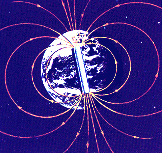
In ancient times, both Greeks and Chinese knew about natural magnets, rare chunks of iron-rich mineral known as lodestones. The Chinese also knew that if you rubbed a steel needle against a lodestone, in a fixed direction, it also became a magnet. Around the year 1000, they furthermore found that if a magnet or lodestone was placed on a little "boat" floating in a bowl of water, it always pointed in a fixed direction--and for a magnetized iron bar, that direction was always north-south. You could rotate the bowl, but the magnet would keep pointing in the same direction.
The reason, we now know, is that the Earth, too, is magnetic. From that came the magnetic compass, quickly copied by Arab navigators and then by Europeans. We may wonder today--if lodestones did not exist, the compass might have stayed undiscovered for a long time, and would Columbus have ventured so far from land without it?
(In place of slide 2--place a transparent compass atop a vu-graph projector) You can demonstrate this to the class on top of a projector, using a transparent compass--the kind one can place on top of a map to orient it. I have one here with me. However, it is much more impressive to float a small magnetized sewing needle in a Petri dish containing water, on top of that projector. It helps prevent spills if the dish has a cover, which you remove after it is safely on top of the projection glass; or else, fill it (from a cup) after placing it on the projector, to a depth of about 7-8 mm. Have a larger container to take the water afterwards, and just in case, also keep some paper towels on hand. The needle should be the thinnest you can get--a small needle of about 3 cm is OK, heavier ones tend to sink. It should be dry, and handling it helps, as it rubs off some grease from the fingers. Magnetize it by stroking with a magnet--the button magnet used in the next demonstration can serve here. Get several needles, just in case the first one sinks; it may be harder to float a needle again after it gets wet, although a paper towel can help dry it. .Have a small magnet on hand to magnetize the needle. The needle won't sink if you drop it carefully. Hold it horizontally at its middle between two fingers, just above the water, then let go. (Use fingers, not pincers: a lot of those are of iron, and the needle may stick magnetically). (in place of slide 3--floating needle demonstration) Of course, it then points north-south, as you can show by placing the transparent compass (used below in another demonstration) on the same projector top. Not too close, or the two magnetic needles interact. (Also, make sure the auxiliary magnet is well away, or else "north" may be in some funny direction)
But why does it float? Ah, now you can tell students about surface tension, about the thin "skin" of the top layers of water molecules, which stick together, and about water beetles which scurry over the tops of quiet ponds.
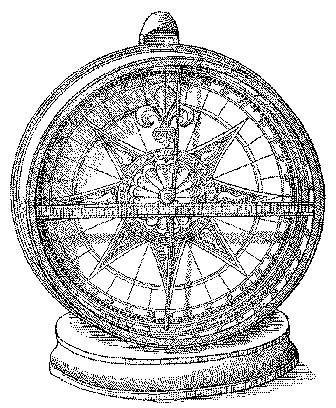
But back to magnetism, although this is mainly about explaining a very fundamental concept in science--the experiment. A scientific experiment is a way of testing nature, to learn how it behaves. By 1580, the use and manufacture of compass needles was a well known art. The maker would take a flat steel needle, find its middle by balancing it, install a pivot there, and then magnetize it by stroking it against a magnet or a lodestone. But that was not enough. The north-pointing end always seemed heavier, and a tip had to be snipped off, to make the needle balance again. The story goes that a compass maker named Robert Norman once snipped off too much and ruined a needle, so he devised an experiment, to find what was happening. Before magnetizing the needle, he balanced it not on a vertical pivot but on a horizontal one, lined up in the east-west direction. (Slide 4, above). Before the needle was magnetized, it stayed horizontal. Afterwards, its north end slanted down. (For some reason, the needle in Figure 4 points straight down, as it would at the magnetic pole.) Aha! The north-pointing magnetic force on the needle was not horizontal, but pointed into the Earth.
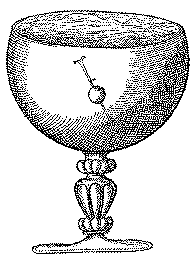 It was a classical scientific experiment, one of the first, and was published in 1581. Norman's contemporary was William Gilbert, distinguished physician and later physician to Queen Elizabeth I. Gilbert devoted much of his energy and money to study magnetism, and in 1600 published his research in a book "De Magnete" (Latin for "On the Magnet"). The preciding visualization of the downward "dip angle" of the magnetic force (Slide 5) is from this book. Gilbert devised an experiment which suggested a reason for the properties of the compass: the Earth itself was a giant magnet. Using as model for the Earth a lodestone fashioned into a sphere (he named it "terrella" or "little Earth"), Gilbert reproduced not only the north pointing properties of the horizontal needle, but also the downward slanting of the needle which Robert Norman made. (Slide 6)

You will find two reviews of Gilbert's book and a lot more, including most of what I am telling here today, in my web course on Earth magnetism, "The Great Magnet, the Earth" With home page http://www.phy6.org/earthmag/demagint.htm . Time is short, so let me just reproduce another projector-top experiment, following an idea of Gilbert.
If you dip a bar magnet into a cup of nails, nails will stick to it. But exactly, why? You know that magnets attract iron, but then you also note, some nails stick to other nails. Why that? Gilbert guessed that the reason was that ordinary iron turned into a magnet whenever it touched another magnet. Soft iron (not steel) loses its magnetism once it is taken away, but while in contact with a magnet, he proposed, it too acts like a magnet, and its polarity is always in a direction which helps it stick to the first magnet. Thus one nail attracts another. He proved his hunch by showing that such temporary magnets not only attracted, but could also repel. He did this by an experiment shown on the above drawing, the frontpiece of his book: the soldier on the right holds two pieces of iron suspended together from strings, just above a magnetized sphere. Their free ends here seem to repel. In actual practice this does not work too well, so we demonstrate the same effect in a somewhat different way. Here is how you perform the experiment in class. Put a magnet on top of the projector, and allow two small nails to attach themselves to adjacent spots on one of the poles, with your fingers holding them parallel to each other. (try holding the ends together by a small wire strand wound around them?) Both nails are now temporary magnets with the same polarity--say, north-seeking or N--at the ends next to the magnet. The polarities of their other ends therefore must be the same--here, south-seeking or S, and those ends should repel each other. By spreading your fingers and allowing the ends of the nails to move apart, you can show that in fact they do. (Slide 7) 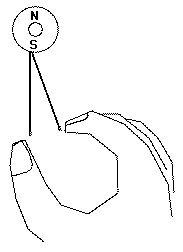
You might also recognize that this is a magnetic analog of the electroscope. (Slide 8) Details of this experiment are at http://www.phy6.org/earthmag/inducemg.htm 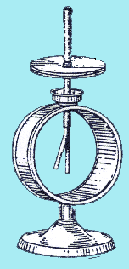
|
